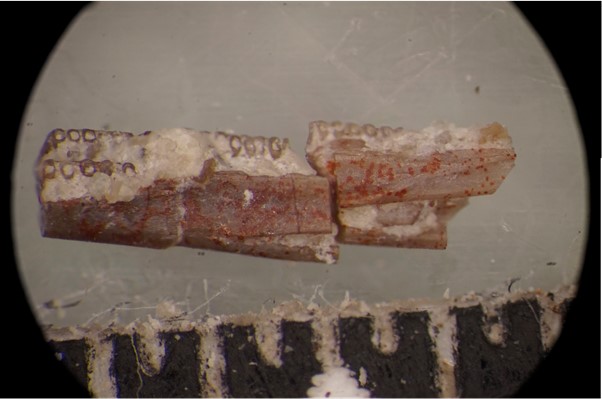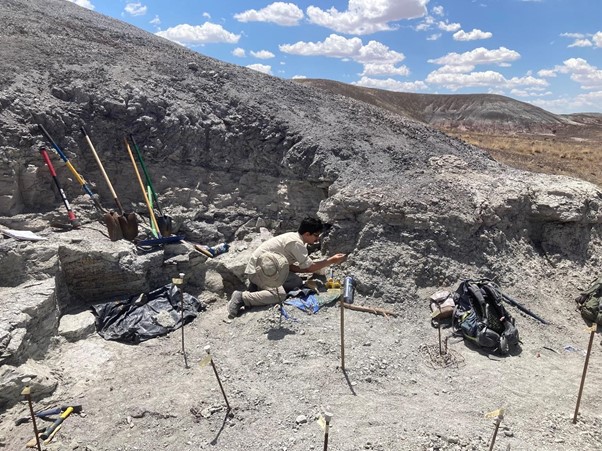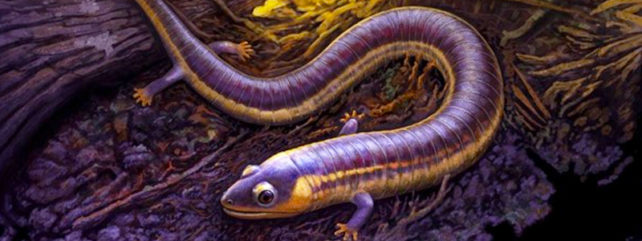Caecilians aren't exactly your run-of-the-mill amphibian. Limbless, toothed, and worm-like, they spend their life burrowing through the soil, sensing the world with tentacles that protrude from between their eyes.
Little is known about these evasive creatures, or how they evolved. Fossils of only 11 species of ancestral caecilians have ever been found, so our understanding of how they are related to other amphibians, such as frogs and salamanders, is fragmented at best.
Now, a team of scientists from the US has uncovered a collection of tiny jawbones representing a new species that plugs a huge gap in the fossil record, revealing more about the unique features of modern-day caecilians and the evolutionary origins of moisty amphibians.
Virginia Tech paleontologist Ben Kligman and colleagues describe finding the fossils – some jawbones no more than a quarter-inch long – in Arizona at a site called Thunderstorm Ridge where the remnants of more than 70 individual caecilians have since been unearthed. They've named the new creature Funcusvermis gilmorei, meaning 'funky worm'.
"Seeing the first jaw under the microscope, with its distinctive double row of teeth, sent chills down my back," says Kligman who was working on the dig with Xavier Jenkins, now a graduate student at Idaho State University.
Given the known age of the fossil deposit and its recognizable teeth, "we immediately knew it was a caecilian, [and] the oldest caecilian fossil ever found," Kligman adds.

The fossil dates back to around 220 million years ago, when the ancient supercontinent known as Pangea had not yet broken apart and Arizona hung about the equator. That means the lucky find pushes the fossil record of caecilians back by some 35 million years.
Before this leap back in time, scientists were struggling to connect the dots between four-legged batrachians (frogs, newts, and salamanders) and caecilians, which together are the living representatives of a group of tetrapods called Lissamphibia.
But the caecilian's position within this group was uncertain. Where along the line did caecilians lose their limbs? Or from whom did frogs evolve theirs? Did their last common ancestor bear the same distinctive two-layer teeth?
There are three prevailing and much-debated theories as to how modern amphibians evolved – a few evolutionary steps down the line from when lobe-finned fishes first crawled onto land, that is.
One theory suggests they evolved from an extinct group of four-legged amphibians called the dissorophoid temnospondyls that lived in the Paleozoic era, some 250 million years ago. Another suggests their origins lie in lepospondyls, a group of early tetrapods that resembled eels and snakes with stumpy legs.
A third but less favored hypothesis is that caecilians descended from lepospondyls and frogs and salamanders evolved from dissorophoids.
In 2008, a creature dubbed 'frogamander' was found in Texas, with a large frog-like head and salamander-like tail. The discovery strengthened evolutionary connections between frogs and salamanders, nesting them within the four-limbed dissorophoids, separate to caecilians.
But the full origin story of Lissamphibia still hinged on caecilians' relationship with their living amphibian relatives, the batrachians, and with ancient Palaeozoic tetrapods. There was still gap of more than 70 million years between the earliest known caecilian fossils and their supposed distant relatives way back in the Palaeozoic.
According to Kligman and colleagues, Funcusvermis slots right into that gap and their new study provides "compelling evidence supporting a single origin of living amphibians within dissorophoid temnospondyls."
Funcusvermis shares skeletal features with early frog and salamander fossils, as well as dissorophoid temnospondyls. Like all modern amphibians, it has rows of distinctive pedicellate teeth, so tiny they look like little nubs on its jawbone. But Funcusvermis lacks certain features of modern caecilians, such as the tenticular sensory organ that their later relatives developed, probably to assist their burrowing noses with smelling.

"Unlike living caecilians, Funcusvermis lacks many adaptations associated with burrowing underground, indicating a slower acquisition of features associated with an underground lifestyle in the early stages of caecilian evolution," Kligman says.
While more fossil finds would certainly help flesh out the evolutionary history of caecilians, for now paleontologists are relishing in the specimens they have chanced upon.
"This find clearly demonstrates that some fossils that you can barely see can greatly change our understanding of entire groups that you can see today," says paleontologist and study author Sterling Nesbitt, also of Virginia Tech University.
The study was published in Nature.
